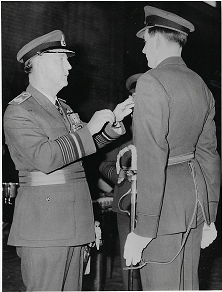Thank you to Owen our Regional Coordinator (North West) for sharing his reflections on remembrance.
A long time ago, when I was a very young and callow Acting Pilot Officer, I was presented with my RAF Pilot’s wings by what appeared to me to be a curmudgeonly elderly Air Chief Marshal. He said very little during the ceremony and even less during the celebratory buffet lunch in the Officers’ Mess afterwards. Many years later I was ashamed to discover that he was a brave hero of the Second World War whose story and those of his comrades in arms must be never be forgotten.
At the time, Air Chief Marshall Sir Kenneth Cross KCB, CBE, DSO, DFC, RAF was in charge of our transport aircraft fleet. But in 1940, Squadron Leader Kenneth Cross commanded No 46 Squadron, equipped with Hawker Hurricane fighter aircraft.
When Norway was invaded in April that year, their aircraft were winched aboard HMS Glorious, a Royal Navy Aircraft Carrier and sent to support the Allied troops trying to maintain a foothold around the town of Narvik. On 26th May, although not designed for carrier operations, 18 Hurricanes were flown off Glorious’ small flight deck and landed at a Norwegian airfield.
Just a few days later, as superior enemy forces were about to overwhelm the poorly equipped ground forces, 46 Squadron was ordered to burn its aircraft, re-embark on Glorious and return to the UK. Nevertheless, the innovative young pilots were determined to get their valuable aircraft home so they experimented with various short landing techniques. They found that the weight of a sandbag placed in the back of the fuselage helped to keep the tailwheel on the ground after landing, preventing the aircraft from tipping on to its nose when braking hard.
Having successfully re-embarked most of its Hurricanes by the 7th of June, the first time that modern landplanes had landed on a carrier without tail hooks to engage the arrester wires, Glorious set sail for Scapa Flow. Unfortunately, all 46 Squadron’s valiant efforts were in vain because none of the aircraft made it home, along with almost all of the ship’s passengers and crew.
On the 8th of June, Glorious was intercepted by the enemy battleships Scharnhorst and Gneisnau and sunk after a two hour one sided sea battle. About 900 men abandoned ship but no emergency signal was received and the first the Admiralty knew about the loss was from an announcement on German radio. Despite a desperate search and rescue operation the position of the sinking was never established.
After 3 days and nights clinging to floats in the freezing arctic waters and purely by chance, a passing Norwegian trawler rescued just 37 men, including Sqn. Ldr. Cross and took them to the Faroe Islands. 1519 men perished in the tragedy.
During the Battle of Britain, Sqn. Ldr. Cross was in hospital then convalescing. But when he had fully recovered from severe frostbite and hypothermia he was posted to the Desert Air Force in North Africa and eventually became a senior officer commanding fighter operations. Returning to England he was involved in the planning and execution of fighter support for the D-Day invasion and the subsequent advance across NW Europe.
“Lest we forget” Owen Hammond

